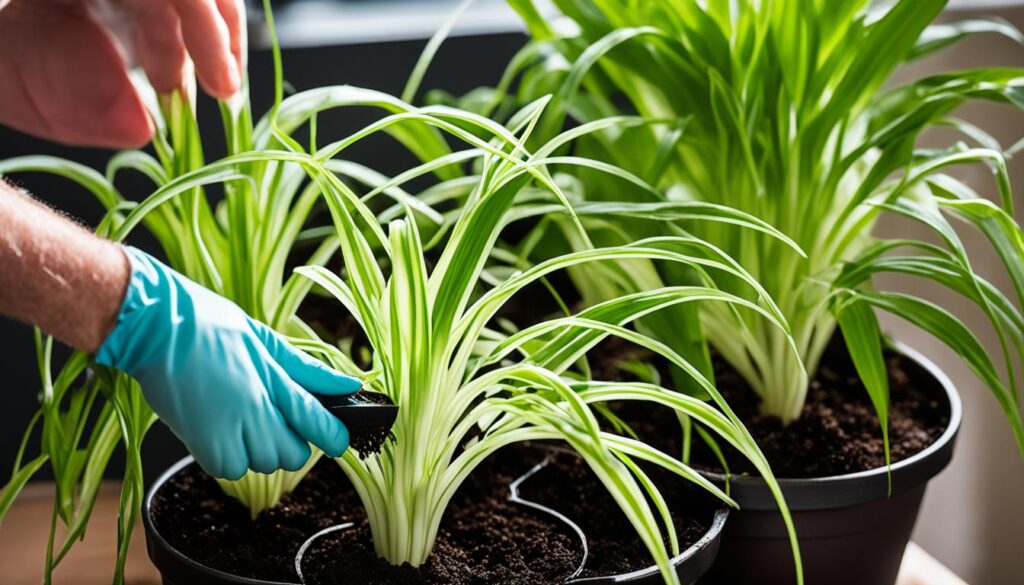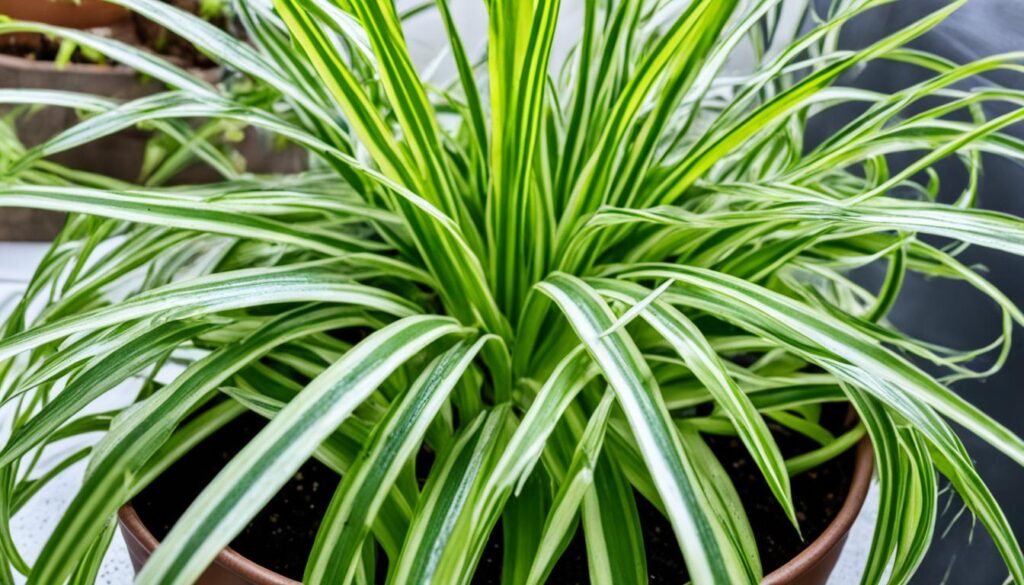
Do you know which houseplant NASA praises for cleaning the air? It’s the spider plant. This simple yet effective plant is a hit with indoor gardeners everywhere.
So, what makes the spider plant so special? This guide will dive into the reasons. We’ll show you how to easily care for and grow these plants in your home.
IN THIS ARTICLE
ToggleWhat Are Spider Plants?
Spider plants, or Chlorophytum comosum, are well-loved houseplants with long, narrow leaves. They form a rosette and are from tropical Africa. Their leaves are green with white or cream stripes, making them stand out.
Aside from looking great, spider plants clean the air. NASA even says they’re great at removing toxins like formaldehyde. This makes them perfect for bedrooms and offices where fresh air is important.
Identifying Features and Benefits
Spider plants look like spiders due to their long, arching leaves. These leaves can be up to 24 inches long and 36 inches wide, creating a hanging, lush look. They also bloom white flowers that produce «spiderettes» for easy new plant growth.
- Distinctive variegated foliage with green and white leaves
- Excellent air-purifying abilities, recognized by NASA
- Adaptable to a wide range of lighting conditions, from bright to low
- Easy to care for and maintain, making them ideal for beginners
- Non-toxic and pet-friendly, making them a safe choice for homes with animals
Spider plants are easy to keep and safe for pets. They’re perfect for anyone interested in indoor gardening. Their air-cleaning skills and ease of care make them a favorite for many.
Caring for Your Spider Plant
Spider plants are great for inside and easy to care for. Giving your spider plant attention will make it grow well. We’ll talk about the key things like how much to water and the best light for it. We will also cover the right temperature, humidity, and when it needs feeding.
Watering Your Spider Plant
Give your spider plant just enough water, not too much or too little. Here’s when to water: Once the top of the soil is dry, it’s time. You won’t want the soil soaking wet or desert dry. Depending on the season, it may need water every week or every ten days. Make sure the pot has holes in the bottom to let water out.
Lighting Requirements
They love bright light but not the sun directly on them. Find a place with lots of light coming in but not hitting the plant directly. Too much sun can hurt the leaves. If your room doesn’t get much light, think about adding special lights for plants.
Temperature and Humidity
These plants like it not too hot, not too cold, between 55°F to 80°F (13°C to 27°C). Don’t put them where they’ll get chilly drafts. Regular room humidity is just fine, but if it’s super dry, help the plant by misting it or using a tray with pebbles and water.
Fertilizing Spider Plants
Feed your spider plant every two to three weeks in spring and summer. It’s like giving them vitamins. But don’t give too much. Dilute the food to half its normal strength. Stop feeding in fall and winter so the plant can take a break.
Pruning and Grooming
Cut off any leaves that are dead or look bad. Snip them right at the bottom. If your plant looks too full, you can trim it a bit. But don’t cut off more than a third of it at once.
These simple steps will help your spider plant be happy and healthy. Just keep up with the right amounts of water, light, and food. Your plant will grow full and green. And you might even see some baby plants popping up next to it, which are super cute.
Spider Plants: Propagation and Repotting
Spider plants are famous for making «spider plant babies» on their stems. These little plants, called spiderettes, are easy to grow into more spider plants. This lets you give them to others or grow more for yourself.
Propagating Spider Plant Babies
To make a new spider plant, cut off a spiderette that has roots. Then, plant it in its own pot with good soil. Or, keep the baby connected to the parent and put the whole stem in soil. This works well for hanging spider plants.
It’s important to keep the soil damp as the new plant takes root. This may take a few weeks. Growing several babies in one pot makes your plant look fuller and bushier.
Repotting Spider Plants
Spider plants need new pots every one to two years when they get too big. Choose a new pot that’s a bit bigger than the old one. Use a good potting mix without peat. Don’t repot in winter, it might harm the plant.
When repotting, take the plant out carefully and cut any bad roots. Put it in the new pot and fill the sides with soil. Water it well but don’t overwater. Your plant will need some time to get used to its new space.
| Propagation Method | Advantages | Disadvantages |
|---|---|---|
| Rooting Spiderettes in Water |
|
|
| Planting Spiderettes Directly in Soil |
|
|

By learning how to propagate and repot spider plants, you can keep them healthy for years. They are simple to care for and grow quickly. With some care and the right methods, you’ll have beautiful spider plants for a long time.
Troubleshooting Spider Plant Issues
Spider plants are tough, but they do face problems. To keep your spider plant healthy indoors, it’s important to know how to solve these issues.
Addressing Leaf Discoloration and Drying
Brown, dried leaf tips are a major issue. This often means the plant is not getting the right amount of water or the water has too many chemicals. To fix it, carefully cut off the brown parts. Then, make sure you water your plant just right.
Combating Pests
Spider plants can get pests like mealybugs and aphids. You can use organic insecticidal soap to get rid of these bugs. Or, you can pick them off by hand.
Promoting Healthy Growth
If your spider plant isn’t making offsets, a few things might be wrong. It could be too young, in a pot that’s too big, or not getting enough light. Fixing these issues can help the plant grow new offshoots.

By tackling these common problems, you can keep your home full of beautiful spider plants. Keep a close eye on your plants, and give them the care they need. This way, you can enjoy their beauty for a long time.
Where to Buy Spider Plants
Spider plants are easy to find. You can get them from many places. Visit online stores like Crocus, Suttons, and Thompson & Morgan. They have a lot of types, even special ones like ‘Vittatum’ and ‘Variegatum’. You can also check at your local nurseries, garden centers, and stores for houseplants.
When buying a spider plant, pick one that looks healthy and clean. Make sure the leaves are bright and not damaged. Think about what you want, like the color of the leaves or how it grows. This helps you choose the best spider plant for your space. Online shops often have lots of info and reviews to guide your choice.
Look out for good deals, whether you’re shopping online or in a store. Sometimes, certain spider plants might not be available. But, you may find others on sale. Don’t miss out on special deals, like free shipping or discounts. It’s a great way to save money and still get what you want.



